Black Widows

Photo Courtesy of Outdoor Life
Black widows are highly venomous spiders typically found in temperate regions. Although venomous, their bites rarely result in death.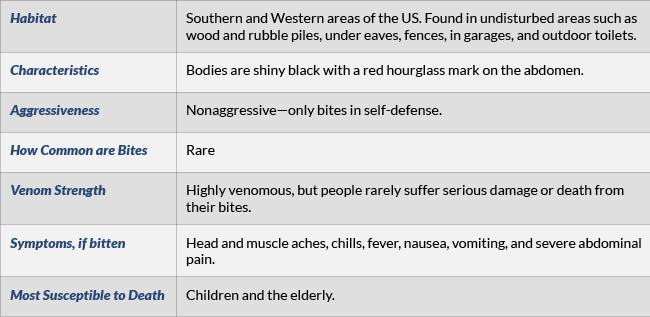
Brown Widows
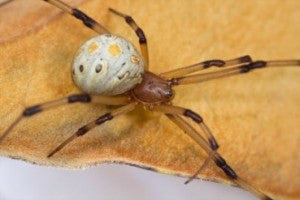
Photo Courtesy of the Center for Invasive Species Research
Brown widows are closely related to black widows, although they choose to build their webs in more exposed areas. This increases the chance of people stumbling across them and getting bitten. Brown widows deliver an extremely painful bite leading to some critical symptoms.
The Red-Legged Widow Spider
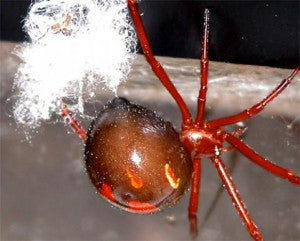
Photo Courtesy of Outdoor Life
The Red-Legged Widow spider is an extremely rare spider, meaning its bites are also rare. This spider, along with the other members of the widow family, has venom “10-25% more potent than a rattlesnake,” according to Survive Outdoors, Inc. and Outdoor Life. However, a widow delivers a much smaller amount of venom than a rattlesnake does, so the effects of the bite are less drastic.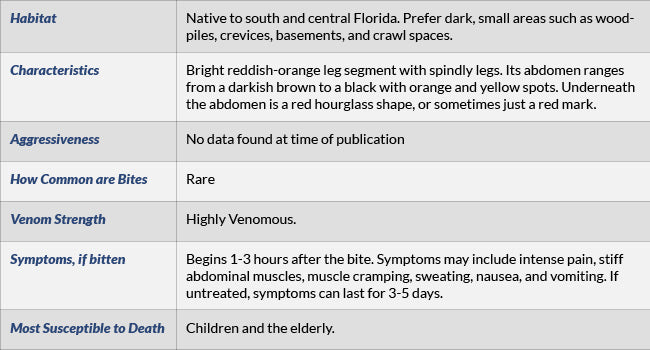
Brown Recluse Spider (aka, The Violin Spider)
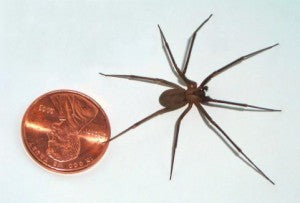
Photo Courtesy of Outdoor Life
The Brown Recluse is one of the most deadly and aggressive spiders you may encounter. They often hide in secluded areas. According to the Center for Invasive Species Research, “the brown recluse spider cannot bite humans without some form of counter pressure, for example, through unintentional contact that traps the spider against the skin.” This counter pressure could even be as simple as rolling over on top of a brown recluse in bed.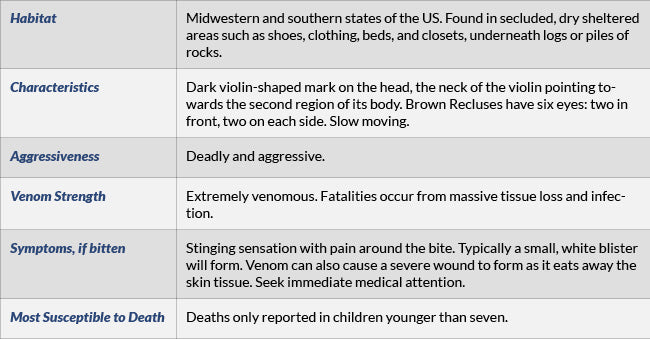
Hobo Spider
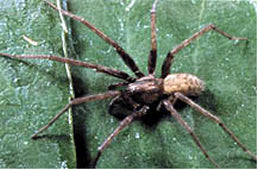
Photo Courtesy of Center for Disease Control and Prevention
Hobo spiders create funnel webs in small crevices, holes, or cracks to catch prey. The web spreads across a surface and then narrows into a funnel much like a tornado with a wide top. A hobo spider will wait just at the mouth of the funnel for prey to drop onto the exposed web before jumping out to attack. Hobo spiders aren’t the only spiders to make webs like this, however, so just seeing a funnel web doesn’t mean you’ve found a hobo spider.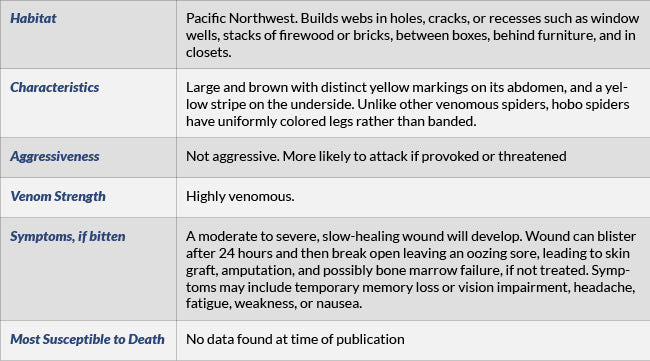
Wolf Spider
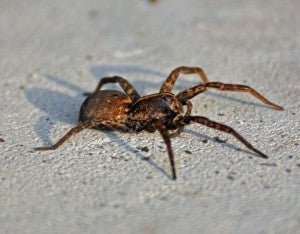
Photo Courtesy of Outdoor Life
Wolf spiders are common around houses and in gardens, and although venomous, they aren’t lethal to humans. Their bite can cause quite a bit of pain, however, and can progress into a serious infection if not treated. On the other side of the coin, they are deadly to their prey. Wolf spiders don’t build webs to catch their prey; rather a wolf spider hunts its prey down to feast.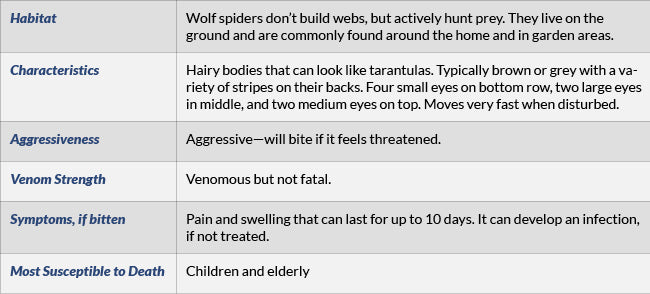
First Aid
The best thing you can do if a spider bites you is to catch it—no joke. It’s often helpful for medical professionals to know exactly what type of spider was the culprit so they can determine the right actions to take. So, if a venomous spider bites you, try to catch it in a jar and seek medical attention immediately. Until you can get to a medical facility, you can slow the spread of venom by taking the following precautions from the Centers for Disease Control and Prevention and the Mayo Clinic:- Cleanse the wound. Wash the area with soap and water to prevent an infection.
- Slow the venom’s spread by tying a bandage and slowing your breathing. If the bite is on an appendage, tie a bandage above the bite snugly and elevate the limb, if possible. Make sure the bandage is only tied snug and not tight to avoid cutting off circulation.
- Apply a cold, damp cloth or ice pack to the bite to reduce swelling.
- Do not attempt to remove the venom.
- Seek medical attention immediately. And don’t forget to take the culprit.
How to Identify a Bite
According to Survival Life, if you find a spider bite on your skin, but don’t actually see the spider, you can try to identify it based on two features of the bite: the level of pain and the resulting skin damage. Black Widow A black widow’s bite will typically feel like a pinprick and at first you may not even notice anything except a little swelling and some red marks that may be hard to see. However, in just a few hours the bite can turn from unnoticeable into extremely painful with fevers, chills, and body aches. Hobo Spider A hobo spider can also cause skin damage like a Brown Recluse, but on a much smaller scale. Brown Recluse A brown recluse’s bite feels like a mild sting, but usually you won’t feel it at all. The first pain you’ll feel usually occurs several minutes to hours after the bite. A blister will form and then rupture leaving behind a gaping ulcer that can appear bright red or even black (after the skin has died). As the tissue dies, the pain increases. If the bite looks like a red spot with a black center and it’s spreading, you’re most likely looking at a brown recluse bite.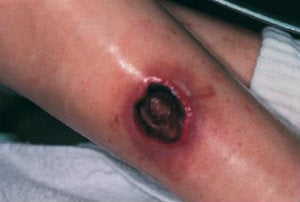
Courtesy of Survival Life
The best thing you can do is to prevent a bite in the first place. Shaking out clothing, wearing long-sleeved clothing, trimming tall grasses, minimizing space between boxes, and getting rid of rubble or log piles are all ways to reduce the risk of getting a venomous spider bite. Have you ever been bitten by a venomous spider? What was your experience? -Kim http://www.outdoorlife.com/photos/gallery/survival/2011/10/10-most-dangerous-spiders-world http://www.termite.com/spider-identification.html http://www.ento.csiro.au/education/allies/araneae.html http://www.surviveoutdoors.com/reference/spiders/red_widow.asp http://www.cdc.gov/niosh/topics/spiders/ http://pubs.ext.vt.edu/444/444-422/444-422.html http://spiderbites.net/wolf-spider-bite/ http://www.ipm.ucdavis.edu/PMG/PESTNOTES/pn7488.html http://www.hobospider.com/info/ http://www.mayoclinic.org/first-aid/first-aid-spider-bites/basics/art-20056618 http://survivallife.com/2013/02/07/spider-bite-treatment-symptoms-pictures/ http://www.tsusinvasives.org/database/brown-widow.html
5 comments
Kay
The Brown Recluse is also found in Eastern Washington State. I was a clinical nurse and several patients with bites, abcesses, holes.
One patient even waited so long that he died.
So be aware Washington State.
Kay
Blitz
I’ve been bitten by brown recluse three times, the first on the calf of my leg, that one took antibiotics and time to heal, the second on my arm, and I immediately started a course of antibiotics and used antibiotic ointment on the bite. The third time was again on my arm, it didn’t progress nearly as fast, I again used disinfectant and antibiotic ointment and it cleared on its own. Maybe my body is creating antibodies now for that venom.
mar
Was bitten twice on same arm (at the wrist & inside forearm) while pulling tall weeds in garden. Noticed pain immediately and raised swelling (little smaller than dime size at first, then got larger with small black spot in middle after only 5 minutes).
Used old folk medicine remedy: Wash area with white vinegar and singed black spot with end of lit match that I had just blown out while tip was still red. It left a deeper hole and larger black spot when it broke through the skin to the venom sac. Took almost 2 weeks to heal, Now I have a small red, flat scar on the skin in both places.
The arthritic-like pain subsided in two days after the initial bite. I believe if I would not have broken up the poisonous venous with the acid from the vinegar and the heat from the match end, the pain that was spreading up my arm would have advanced and the damage to the skin surrounding the wound would have been greater.
beprepared
Stephen,
Thanks for sharing. I’m glad you’re ok and that it healed quickly. Given your experience, what advice would you give others for protecting themselves from spider bites?
Angela
STEPHEN SCHNUR
I WAS BITTEN BY A BROWN RECLUSE SPIDER ON MY STOMACH , WE WERE TEARING DOWN A SHED AND IT GOT UNDER MY T-SHIRT. AT FIRST IT TOOK ON THE LOOKS OF A BULLSEYE, THEN IT BECAME ABOUT DIME SIZED WITH BLACK CENTER.
IT TOOK WEEKS TO HEAL AND WAS ABOUT ONE HALF INCH DEEP. IT HAS LEFT A SCARE THAT LOOKS LIKE I WAS SHOT ABOUT HT ESIZE OF A DIME.